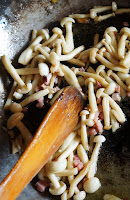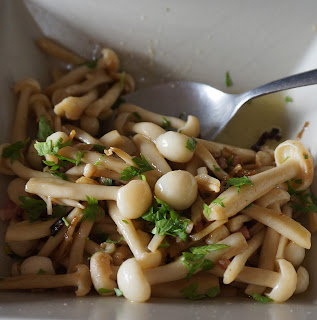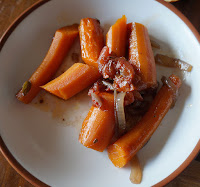Do you ever come across a recipe on Instagram that you’ve just got to try? Me, rarely. But a post for potato tortilla with wakame seaweed from Porto-Muiños (#portomuinos), Galician harvesters and distributors of algae products, grabbed me. An interesting variation on a classic and I just happened to have all the ingredients to hand.
I can buy several types of algae at my local market at the “health food” stall. Wakame is my favorite. It tastes like a sea breeze smells and is nicely chewy. I use wakame in salad with sesame to accompany sushi, poke and tuna tataki. But, seaweed with potatoes cooked in olive oil? Yes! Wakame adds an interesting flavor as well as texture.
 |
| Shards of dry wakame. |
Wakame comes layered in stiff sheets that have been pressed and dried. After 10 minutes of soaking, it turns from black to dark green and softens to a chewy consistency. Once rehydrated it can be used raw or cooked.
I accompanied the seaweed tortilla with a mushroom sauté al ajillo which also was a variation on a traditional recipe. Instead of the usual champiñones I used white shimeji mushrooms, a product that recently turned up at my local grocery store. With some cherry tomatoes the tortilla and mushrooms made a delightful vegetarian lunch.
 |
| Tortilla is perfect for a vegetarian lunch. |
 |
| Variation on a theme: champiñones al ajillo made with shimeji mushrooms. |
Potato Tortilla with Seaweed
Tortilla de Patatas con Alga
The Porto-Muiños recipe calls for patatas gallegas, Galician potatoes. Those with the PDO Indicación Xeográfica Protexida Pataca de Galicia—protected geographic indication, potato of Galicia, are the Kennebec variety. Not always available where I live, I used ordinary russet-type potatoes for this tortilla.
Potatoes for tortilla are best cooked slowly—not fried—in lots of olive oil. The potatoes absorb very little of the oil, which can be strained and used again. I like onions in tortilla, although the recipe from Porto-Muiños didn’t include them. Your choice.
½ ounce dry wakame
1 pound potatoes
½ cup olive oil
Salt
3 tablespoons chopped scallions (optional)
6 eggs
Freshly ground black pepper
 |
| Wakame after soaking. |
 |
| Cook eggs and potatoes to set. |
Peel the potatoes and slice them thinly. Heat the oil in a large skillet. Add the potatoes, lower heat and cook the potatoes, turning them frequently, without letting them brown. Sprinkle with ½ teaspoon salt. When potatoes are almost tender, about 15 minutes, add the scallions, if using. Cook another minute. Remove the potatoes and onions with a skimmer. Reserve the oil.
Beat the eggs in a bowl with 1 teaspoon of salt and pepper. Add the wakame and potatoes. Let the mixture stand 10 minutes.
Add 1 tablespoon of the reserved oil to a small (8-inch) no-stick skillet. When hot, pour in the egg-potato-wakame mixture. Stir it gently for 30 seconds, then allow to set on the bottom, 3-4 minutes. Adjust heat so that it doesn’t brown or scorch.
Have ready a flat plate or pan lid. Place it on top of the skillet and hold it tightly while reversing the skillet so that the tortilla turns out onto the plate. Carefully slide it back into the skillet to cook on the reverse side, about 2 minutes. Lift the edge of the tortilla and slide it onto a serving dish.
Serve the tortilla hot or room temperature.
Shimeji Mushroom Sauté
Setas Shimeji al Ajillo
White shimeji mushrooms, also called beech mushrooms, are a cultivated version of a wild fungi. They somewhat resemble enokitake mushrooms—shell-like caps with slender stems. Sauté them quickly for a slightly crunchy finish or add them to stews and soups to cook to chewiness.
Chopped ham is often added to mushrooms al ajillo. If you’re cooking a vegetarian meal, just omit it.
 |
| Slice root-end off shimeji mushrooms. |
Serves 2-4.
1 bunch (about 6 ounces) shimeji mushrooms
3 tablespoons olive oil
2 cloves garlic, sliced
Red pepper flakes
½ ounce diced serrano ham (optional)
Salt
2 tablespoons dry Sherry
2 tablespoons chopped parsley
 |
| Fry with garlic. |
Wash the whole bunch of mushrooms in a bowl of water. Drain. Cut off and discard the clump of root ends. Separate the mushrooms. Heat the oil in a skillet. Add the garlic and red pepper flakes and fry them 30 seconds. Add the mushrooms and sauté 1 to 2 minutes. Add the ham, if using, and Sherry. Cook 1 to 2 minutes until the alcohol is cooked off. Serve the mushrooms hot garnished with parsley.
 |
| Shimeji mushrooms sautéed with garlic, finished with Sherry. |
More recipes with seaweed:
More about Galician potatoes here.
More tortilla recipes:

































